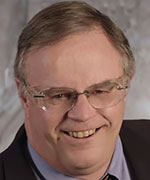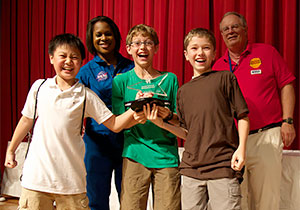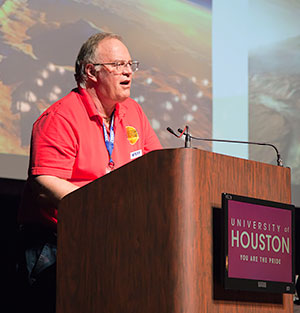Passion for STEM Education and Advancing State of the Art in Aerospace
 His passion for STEM education and devotion to advancing the state-of-the-art in aerospace
garnered Edgar A. “Gar” Bering III recognition in the American Institute of Aeronautics
and Astronautics’ Momentum Member Spotlight. AIAA is the world's largest technical
society dedicated to the global aerospace profession.
His passion for STEM education and devotion to advancing the state-of-the-art in aerospace
garnered Edgar A. “Gar” Bering III recognition in the American Institute of Aeronautics
and Astronautics’ Momentum Member Spotlight. AIAA is the world's largest technical
society dedicated to the global aerospace profession.
Bering, a professor of physics and electrical and computer engineering, is well known at UH for his leadership of the Mars Rover Celebration, which is now in its 13th year. However, his STEM efforts aren’t contained to the Greater Houston area. An AIAA Associate Fellow, he is the immediate past chair of the AIAA’s Science Technology Engineering and Mathematics K-12 Outreach Committee.
 Bering, also a member of the AIAA’s Atmospheric and Space Environments Technical Committee,
sites his favorite aerospace memory as “leading the 1985-86 South Pole balloon campaign.”
Bering, also a member of the AIAA’s Atmospheric and Space Environments Technical Committee,
sites his favorite aerospace memory as “leading the 1985-86 South Pole balloon campaign.”
The AIAA Member Spotlight provides an entertaining review of Bering’s own inspiration to pursue a STEM career, his advice to high school and college students interested in STEM, and his views on the role of AIAA in the STEM K-12 community.
Read Full Article on AIAA or below.
Momentum Member Spotlight: AIAA Congratulates Professor Edgar Bering III
By Duane Hyland, AIAA Communications
 The Member Spotlight swung in a southwesterly direction this month to the city of
Houston, Texas, to the campus of the University of Houston where it fell on Professor
Edgar Bering III, a passionate voice for the furtherance of STEM education for our
nation’s schoolchildren.
The Member Spotlight swung in a southwesterly direction this month to the city of
Houston, Texas, to the campus of the University of Houston where it fell on Professor
Edgar Bering III, a passionate voice for the furtherance of STEM education for our
nation’s schoolchildren.
Bering, a Professor of Physics and Electrical and Computer Engineering at the University of Houston, as well as a Professor of Physics at the University of Houston – Clear Lake, is the immediate past Chair of AIAA’s Science Technology Engineering and Mathematics (STEM) K-12 Outreach Committee. He also serves as the Regional Deputy Director of STEM for AIAA’s South Central region, and chaired the Education Activities Committee’s STEM K-12 Subcommittee. Beyond being a passionate advocate for the importance of quality STEM education for our nation’s young people, Bering is also equally devoted to advancing the state of the art in aerospace, serving as a member of the Atmospheric and Space Environments Technical Committee, and has published over 119 peer-reviewed works during his career. Bering received an AIAA Special Service Citation in 2005 for “organizing the Mars Rover Competition as Part of the 2002 World Space Congress and establishing it as a yearly event.”
Outside of AIAA, Bering continues his support of education as a member of the West Houston P-16 Council, an organization promoting “success across the educational continuum – Pre-K through college and workforce development - for children and young adults in West Houston.” Among the focuses of the group are: “Improving math transition from middle school to high school with a goal of increasing the number of high school students College Algebra and Calculus ready; Increasing the number of high school graduates who participate in higher education within one year of graduation; and providing mentors for 8th/9th grade students.”
Like so many other spotlight subjects before him, Bering said that his love of space is long standing, noting “to be honest, I have been a space enthusiast for as long as I can remember.” However, Bering explained that it was another pair of innovators who first captured his imagination about the technical side of space exploration, relating: “One early memory I do have is watching the Walt Disney–Wernher von Braun short subject movies on space exploration, especially one that featured Ernst Stuhlinger discussing sending a fleet of manned spacecraft to Mars using Cesium ion engines. Shortly after watching the Mars one, I can remember asserting fiercely on the playground in 3rd grade that I was going to grow up to help build the ships for the manned Mars mission.” Bering went on to note that the news that he wanted to enter STEM was not enthusiastically received by his classmates, who, almost predictably, “mocked and bullied him” for his choice. Often bullying like this often derails careers before they even begin as the abuse makes children reluctant to continue to pursue STEM studies in order to “fit in.” But Bering had the last laugh, reflecting “when I finally joined the VASIMR team at NASA’s Johnson Space Center in 1996, and when designing the sustainer engines for the mission became my day job, I took great delight in notifying the school alumni notes of this,” sending a message that with perseverance, belief in oneself, and hard work, other students could achieve their STEM career goals, despite what classmates say.
Bering cited his parents as a primary source of inspiration to become involved in STEM, if not aerospace directly, as “there were no pilots or engineers” in his family, explaining: “My dad was a neurosurgeon and my mom an MIT-trained biophysicist. Growing up, thanks to Heathkit, FAO Schwarz chemistry kits, and the New York Academy of Science experiments of the month, I lived in a deliberately hyper-enriched STEM environment.” Bering also let me know that those wonderful Disney-von Braun films can still inspire young minds today, as they “can still be purchased as a boxed set of DVDs under the Disney Treasures line,” perhaps making a great gift for a student interested in space exploration and technology, or in classic Disney filmmaking.
Bering’s career highlight thus far and favorite aerospace memory was his “leading the 1985-86 South Pole balloon campaign,” which launched “eight stratospheric balloon payloads from Amundsen-Scott South Pole Station, Antarctica, at the geographic South Pole” that summer. The program took long-term measurements of various features of the South Pole’s ionospheric electric field.
If you are a college student thinking about entering the aerospace community, Bering enthusiastically exhorts you: “Do it, it will be more fun than you can imagine!” But he also provides this advice: “Take more math than required. Learn to code fluently. Learn the basics of circuit design and PCB fabrication,” and, most practically, “Learn how to machine and weld materials.”
Bering, not surprisingly, feels that there is always a need for our educators to become more proficient in STEM areas. He envisions a world where aerospace professionals work with teachers to increase their teaching skills and technological knowledge – so that students get the best STEM education possible. To do that, he advises teachers to “become an Educator Associate member of AIAA. Seek out your local AIAA Section and get involved. Come to Section meetings and meet people.” He also urges AIAA members to “take the Engineers as Educators training, and work with local teachers to help them use the AIAA Educator Academy curricula.”
If you are a high school student thinking about entering the aerospace community, Bering advises you to “Take lots of math. Then, take more. Join a robotics program. Take shop. Learn to make stuff.”
In discussing the role of AIAA in the life of an aerospace professional, Bering maintains that “AIAA and the other professional societies are an important aspect of being an effective, productive engineer. Through AIAA, one can stay abreast of best practices, contribute to writing standards and best practices and develop the contacts needed to be effective in a global economy.” However, when discussing the role of AIAA in the STEM K-12 community, Bering said “AIAA has a ways to go in developing an effective STEM program,” stressing “the need to recognize the vital importance of making positive AIAA contact with every child in the country and adopt it as a real objective. We also need to produce programs that not only comply with professional Outreach community best practices, but also take the lead in improving those practices. Providing improved membership value to members whose day job is aerospace STEM outreach is a significant near term challenge.” He closed his jeremiad by confidently expressing “with aerospace as a subject, we have an ability to help teachers bring the lightning and the magic back to classrooms that no other organization can match. It is crucial that we do so!”
AIAA congratulates Edgar Bering III on his selection as the AIAA Member Spotlight for August 2014, and thanks him for his passionate commitment to, and advocacy for, STEM education for our nation’s young people—especially as education, and our members’ commitment to it, truly shapes the future of aerospace.